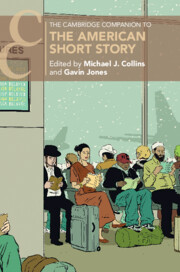Book contents
- The Cambridge Companion to the American Short Story
- The Cambridge Companion to the American Short Story
- Copyright page
- Contents
- Figures
- Tables
- Contributors
- Chronology
- Introduction
- Part I Contexts
- Part II Histories
- Chapter 7 The War Story
- Chapter 8 Narratives from Below
- Chapter 9 The Short Story and the Popular Imagination
- Chapter 10 Love What You Do
- Chapter 11 Local Color to Multiculturalism
- Part III People and Places
- Part IV Theories
- Notes
- Further Reading
- Index
- Cambridge Companions to…
- References
Chapter 8 - Narratives from Below
Working-Class Short Fiction
from Part II - Histories
Published online by Cambridge University Press: 11 May 2023
- The Cambridge Companion to the American Short Story
- The Cambridge Companion to the American Short Story
- Copyright page
- Contents
- Figures
- Tables
- Contributors
- Chronology
- Introduction
- Part I Contexts
- Part II Histories
- Chapter 7 The War Story
- Chapter 8 Narratives from Below
- Chapter 9 The Short Story and the Popular Imagination
- Chapter 10 Love What You Do
- Chapter 11 Local Color to Multiculturalism
- Part III People and Places
- Part IV Theories
- Notes
- Further Reading
- Index
- Cambridge Companions to…
- References
Summary
The short story became a popular form among twentieth-century working-class writers, who faced challenges in maintaining a literary career while short on time and energy. Meridel Le Sueur, Tillie Olsen, Raymond Carver, and Bobby Ann Mason also found the short story to be an effective form for representing the experiences of those who were alienated within US society. This chapter argues that the comparably abrupt and disconnected nature of the short story parallels an aesthetic of disconnectedness that is prevalent in the work of these four writers, each of whom portrays working-class life as alienated from the mainstream culture, and whose characters are often emotionally stunted as a result. While the later writings of Carver and Mason reduce the earlier emphasis on economics and class struggle found in Olsen and, especially, Le Sueur, they all share a sense of the emotional damage caused by being working class in the United States.
Keywords
- Type
- Chapter
- Information
- The Cambridge Companion to the American Short Story , pp. 131 - 145Publisher: Cambridge University PressPrint publication year: 2023

